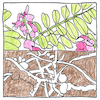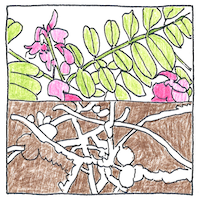Hermann Hellriegel
botany

|
Nitrogen fixation
The practice of planting beans to improve the next crop had been known since the Egyptians and the Greeks. Why this worked wasn’t known until Daniel Rutherford isolated nitrogen from air and Hellriegel and Hermann Wilfarth figured out that the bacterium Rhizobium growing in nodules on the roots of legumes converts nitrogen gas into a soluable form that plants can use.
Mysterious biology
Odd that all living organisms should require the most abundant element in only small amounts except for the difficulty of breaking the bonds of nitrogen gas to render it as ammonia or nitrate and as for that no industrial process can compete with the efficiency of natural processes.
Natural efficiency
Green plants generate energy from photosynthesis more efficiently than the best solar panels. Green plants work with bacteria to fix nitrogen more efficiently than any industrial process. This could explain why it’s so hard to rid my yard of snails and weeds.



Earth’s atmosphere is 78.09% nitrogen in its diatomic form (N2), in which pairs of nitrogen atoms are joined by an extremely strong bond. All living organisms require nitrogen in their DNA and RNA; all green plants require nitrogen as a primary nutrient. About 3% of the human body is nitrogen.
After diatomic nitrogen is broken, it can be combined with other elements into many useful forms, including ammonia (NH3), nitrate (NO3) used for artificial fertilizers, nitric acid (HNO3), nitroglycerin used for explosives such as dynamite, and cyanides (which include a nitrogen atom triple-bonded to a carbon). When these compounds decompose back to nitrogen gas, they release large amounts of energy, and can, therefore, explode.
Rhizobia are not the only miracles of nature that fix nitrogen. Some non-legumes have nitrogen-fixing symbiotic associations with cyanobacteria or Frankia bacteria. All natural nitrogen-fixing processes use an enzyme complex named nitrogenase. Also, there are industrial processes to create ammonia and other nitrogen compounds including a process based on a method used by Henry Cavendish in 1784.
See also in The book of science:
Readings in wikipedia: